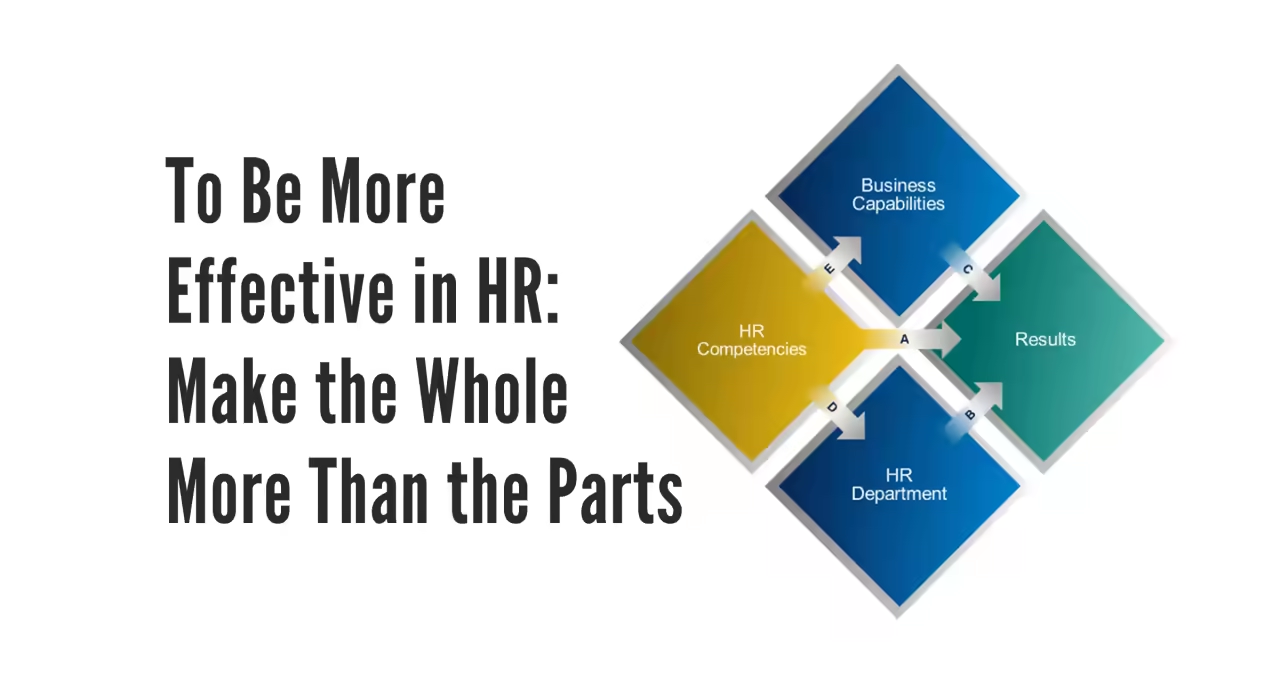Pat Wright, and Erin Burns have recently shared the results of the eighth round of the HR Competency Study (HRCS). Sponsored by Ross Executive Education at the University of Michigan and The RBL Group with partnership of nineteen global HR associations, this study has data from about 29,000 HR and non-HR professionals. Their overall model reinvents how to navigate HR’s impact on business results (see figure for overall model). Let me provide some commentary on this defining research to reinforce insights and implications for the HR agenda going forward. (Full disclosure: I have been centrally involved in this HRCS research since 1987, but I am an advisor and not a principal investigator on this eighth round.)
As stated, this research reinvents how to navigate HR’s impact through three questions. (Note that in the seventh round of research, paradox navigator mattered most for business results; now the broader focus is on navigating HR’s impact.)
- What competencies do HR professionals need to deliver results (Path A)?
- What should be the characteristics of an effective HR department (Path B), and what individual HR competencies shape HR department effectiveness (Path D)?
- What business capabilities should HR help create to deliver business results (Path C), and what individual HR competencies help embed business capabilities (Path E)?
Figure: Reinventing how to Navigate HR’s Impact HR Competency Study Round 8
While the study includes many subtle and significant findings and implications , one meta-message stands out: HR’s greatest impact on business comes from making the whole more than the parts. The HR department and business capabilities that HR helps create have six to eight times more impact on business results than individual HR competencies. This finding is consistent with previous research in the book Victory Through Organization.
This finding—that the HR department and business capabilities have more impact on the business results—has parallels in many fields:
- In sports, individual players may be champions, but teams generally win championships. The leading scorer in almost any team sport (basketball, hockey, soccer/football) is seldom on the team that wins the championship.
- In movies, the winner of the leading actor or actress academy award is seldom (less than 20 percent) in the movie that wins movie of the year honors.
- In music, the band generally outperforms the individual artists if a band disbands.
- In psychology, physical features of an individual (e.g., height, weight, hair or eye color, body type, etc.) do not affect personal outcomes, but rather the personality of the individual that is a collection of personal traits do (e.g., the Big Five).
- In managing change, hosting an event is less sustainable than exploring and changing a long-term pattern or process.
- In fashion, one item of clothing (shirt, scarf, accessory) does not denote style but rather the coordination of clothing into an ensemble.
- And the list could go on and on and on.
For HR, the whole being more than the parts has many implications:
- HR cannot simply focus only on individuals (e.g., people, talent, competencies, employees, or workforce) but must attend to the collection of how those individual people join together into organization (e.g., process, culture, capabilities, systems, or workplace) by using what we call a human capability blueprint.
- HR cannot isolate and improve a single HR practice area (e.g., hiring people, orienting new employees, training employees, or paying employees) but should emphasize the integration or bundling of these separate HR practices into integrated solutions and patterns, often called high-performance work systems.
- HR cannot just focus on HR time-based events (e.g., annual succession planning, payroll increase, quarterly reviews, or new orientation) but must see to how HR events meld into and create patterns of activities over time.
- HR cannot only focus on a single stakeholder (e.g., the employee or line manager) but should work on a broader stakeholder map of employees, line managers, customers, investors, and communities.
Making the whole more than the parts will require that HR professionals broaden their expectations, horizons, and experiences by adapting some of the following tips.
- Look for patterns. When doing or observing HR work and events, look for the more general patterns of that work. What are the principles or themes governing this HR work? What has happened before? Why does this happen? What are causes and effects that might be replicated in the future? Events are often parts; patterns represent the whole. When engaging with others, identify and share the patterns of work more than the specific HR activities the work. For example, ask, “How do we make sure to continue our pattern to pay for performance?” more than probe the details of a specific appraisal or reward activity.
- Incorporate divergent and convergent views into new ways of thinking. Divergence comes by accessing different opinions and exploring options; convergence comes by seeking common ground and agreeing on actions to move forward. Divergence highlights the parts and innovation; convergence encourages the whole and focused action. Help leaders to continually navigate the divergence/convergence process.
- Focus impact less on “me” and more on “we.” When considering the impact of HR work, explore how all stakeholders are affected by that work, including employees in general, business leaders, business strategy, customers, investors, and communities. By seeing the impact of HR work on all stakeholders, the HR department and business capabilities have more lasting impact. At a personal level, use your strengths and insights (me) to strengthen and empower others (we). For example, ask, “How can our work attend to the needs of all our stakeholders?”
- Attend to capability creation. In dialogues within the HR department and with business leaders, constantly raise “organization capability” issues about having the right culture, identity, processes, and systems. Become an advocate for and architect of the right organization.
The research that the whole (HR department and business capabilities) deliver business results more than the parts (individual competencies) is compelling, and as it shapes thinking and actions, it will help navigate HR’s impact.



